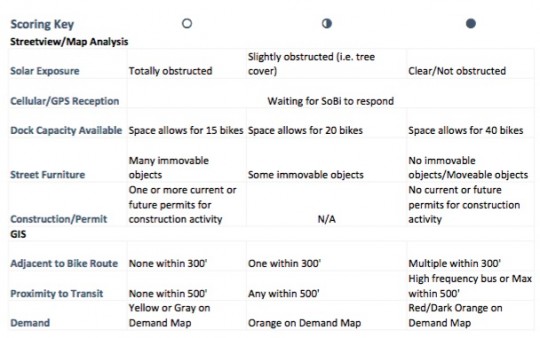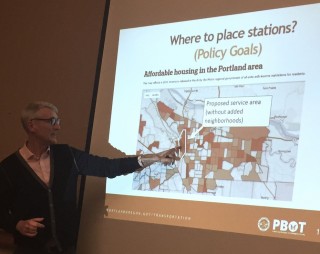
With sponsorship all buttoned up, the next big phase of planning for Portland’s bike share system is where to put the docking stations. And with that aforementioned sponsorship, the City of Portland is in the enviable position of being able to expand Biketown before it’s even been launched.
We got our first look at the new maps — for both the proposed station locations and the service area – at the City’s Bicycle Advisory Committee last night.
“We’re going to get there. But we tried to stick to being successful right out of the gate.”
— Steve Hoyt-McBeth, PBOT bike share project manager when asked why Alberta Street won’t be in the service area.
The $10 million commitment from Nike means Biketown will launch in July 66 percent larger than initially proposed. With 100 stations and 1,000 bikes the service area for the system has now been expanded.
The service area still focuses on the central city, but it’s been expanded to cover more of northwest and southeast Portland. The initial service area (map here) had a northwest border of Raleigh and 24th. That has now been expanded three blocks to Vaughn. The largest expansion comes in southeast. Where the initial map stopped along 12th and went from NE Broadway to SE Powell, the new map extends bike share along SE Clinton and Belmont as far east as Cesar Chavez (39th).
A draft station map released by the Bureau of Transportation today shows 300 candidate locations. Now the process begins for whittling them down to a final 100. PBOT also released an interactive tool that allows anyone to drop a pin on a map and suggest a location.
Before going into the details on how they’ll make their station location decisions, PBOT’s bike share project manager Steve Hoyt-McBeth shared an overview of the system. He said the city’s main goal for bike share is to get people out of their cars. “We want people to bike more and drive less,” he said, pointing to research that shows a strong correlation between bike share use and less driving. One study showed that about 50 percent of bike share users say drove less after becoming members of a system. “Bike share appears to be a wonder drug,” Hoyt-McBeth said, “It just makes people bike like crazy.”
To create bike share addicts the city must first put dealers on every corner — that’s where the stations come in. While you won’t have to park your Biketown bike at a designated station (that’s a key distinction of our “smart bike” system), the city will still rely on them as anchors and they’ll have built-in incentives for people to use them.
Before releasing their maps to the public today PBOT and their consultants have already put considerable thought into what makes a good station location. They worked with Alta Planning + Design to create a heat map of where demand would be greatest. The map took into account factors like residential and employment density, transit demand, “recreation demand” and proximity to major attractions.
PBOT also scored potential locations on a list of 10 criteria that include everything from “solar exposure” (needed to run the on-board electronics) to whether it’s adjacent to an existing bike route.
Another major factor for PBOT’s decisions is equity. Hoyt-McBeth said the new service area has 13,000 affordable housing units, with 80 percent of them just 500 feet from a station candidate and 99 percent within a quarter-mile.
Advertisement
When it comes to building a bike share system that works, station density is a key factor. Portland’s system is aiming for just under 11 stations per square mile — which is about twice as dense as comparable cities. Hoyt-McBeth emphasized that PBOT’s approach is to keep the initial service area as small as possible. “We want to be successful out of the gate and serve our service area well, then use that success to grow into new neighborhoods,” he said.
One part of the city left out of the service area is the bustling Alberta Street area. Hoyt-McBeth said that was his team’s most difficult decision, especially because he and other city staffers live there. The decision came down to density. PBOT feels the system will work best if the coverage area has “contiguous density” of residential and commercial land-use. Hoyt-McBeth said Alberta didn’t make the cut because the Irvington neighborhood directly south of it is simply not dense enough to support bike share.
“We’re going to get there,” Hoyt-McBeth said about the Alberta area. “But we tried to stick to being successful right out of the gate.”
Since the vast majority of Biketown customers will be local residents (as opposed to tourists, which make up a tiny share of users in other cities) and most of Portland’s everyday bike riders already have a bike, PBOT is banking that bike share will appeal to the 60 percent of Portlanders who’d like to try cycling but have various concerns that keep them away. “The ‘interested but concerned’ have been really difficult to move off the fence,” said Hoyt-McBeth, “Bike share seems to be really effective to get people to change their behavior.”
The system will cost $2.50 for a 30 minute ride or you get up to 90 minutes free per day with annual pass that costs $10-$15 per month.
PBOT wants to get the station map finalized quickly in order to stay on track for the July launch. They have five open houses to garner feedback starting next week. You can also suggest a location on their interactive map tool.
Correction 11:30 am: An earlier version of this post referred to stations per acre rather than per square mile.
— Jonathan Maus, (503) 706-8804 – jonathan@bikeportland.org
BikePortland can’t survive without paid subscribers. Please sign up today.


